We’re back with part 2 of our Powerplay article!
Haven’t you read the first part yet? Then click the link below to check it out.
READ – Powerplay essentials: How to set up the Perfect Powerplay
(Featured image by Per Wiklund)
In this article, we’re going to take the basics a bit further and look at some plays with all 5 field players involved. We will draw on the positions and outlines from the first article and see how much further we can take it.
Below you find an index, you can click on the chapters to directly jump there.
Basic Scoring
Of course, we’re not there yet with these basic rules, because we haven’t scored a goal yet! How are we going to proceed from the matters discussed above?
Patience.
And by this I don’t mean that you as a reader should be patient – you can even scroll impatiently if you want to – but that in a powerplay sometimes you have to be patient. Passing around to play your opponent out of position can take time, but in principle, you also have more than enough time. So don’t be afraid to let the ball go around for a long time, as in the example below.
Make sure that there are always two safe passes possible so that the player in the slot is sometimes changing with another player. Also, make sure that the ball goes around the whole field and that there is always a safe option to play it back (to the last player).
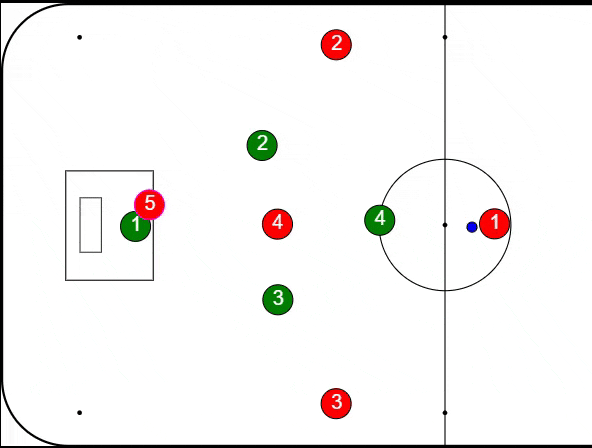
Because the opponent has one player less, they are more or less forced to keep the diamond position in place. The 1-2-1 does slide to the left and right, but the ball side and the auxiliary side are well taken into account. If we have the ball behind the goal, the opponent’s formation becomes slightly more compact (their highest forward moves back a few steps), but if the ball is played back to our #1, the opponent immediately moves back to about 40-50%.
[ppp_non_patron_only]As much as we love floorball, we dedicate a lot of time and money to the FloorballToday project (more info here). That's why we ask you for a small monthly donation. By clicking the button below you can become one of our supporters and read the rest of the article. Thanks a lot! Already a patron? Then here is where you can login. [/ppp_non_patron_only][ppp_patron_only level="6" silent="no"][ppp_patron_only level=”6″ silent=”no”]
In order to score a goal, you’ll want to shoot. With the help of the pass, which is explained in detail above, you try to find the space for a shot. This can be done from a distance, e.g. by the players at the boarding (Left wing and Right wing, #2 and #3) but make sure it is a direct shot so that the goalkeeper has little time to react. In this situation, Johnny Deep (#5) should also be near the goal, preferably to screen and thus obscure the goalkeeper’s view of the ball, but also to score any rebound.
This tactic is simple but still very viable. Don’t forget that you should create a powerplay strategy that fits your team’s strengths and weaknesses. If you have two excellent shooters in your team but your team lacks precise passing, then it’s no shame to try it and see how it works for your team, rather than force a (passing) tactic that you are simply not capable of executing. Also, keep in mind that communicating your powerplay strategy is essential so everyone knows what to do. If Johnny Deep is aware that he will get more rebounds, he can play accordingly. In turn, your powerplay will be more successful.
Another shooting option is one where timing is crucial: the Slot Guy‘s (#4) shot. It is important to consider in advance whether there is a lefty or a righty. The Slot Guy gets the ball from the Left or Right Wing, as shown in the examples below (the dotted line is the pass):


What are the pros and cons of this tactic to score?
Advantages
- Slot Guy is in a great place to shoot
- Only two passes are required
- If Slot Guy can’t shoot the ball directly, he can always bounce it back
Disadvantages
- Slot Guy is the player with the most coverage
- If defender B or C manages to intercept the ball to the middle, there’s a big chance of a counter
- The timing must be perfect
Why does the timing have to be perfect? Because player B or C is often close to Slot Guy. The moment the player on the side gets the ball, Slot Guy has to take a step backward to get out of cover. In that case, the pass must also go straight to the center, at the right speed, and only then can a direct shot be made.
This tactic is often preceded by a number of passes on the other side of the field. For example, let’s take the image above where Right Wing gives the pass from the left side of the field to Slot Guy (which is a righty in this case, since only then can he make a direct shot). It’s useful to start the powerplay now with a number of passes between the Point (#1) and Right Wing and maybe even between Left Wing and Johnny Deep (which is a righty in this case), in order to pull the opponent to the right. Then the Point can determine the moment of the move: he then decides to play the ball to Left Wing, the opponent is out of position, the ball can go to the Slot Guy which results in a direct shot.
Advanced Scoring
If you calmly think about it with a coach board and some magnets, you’ll see that this way of playing can be performed at any position. For example, we have the ball behind the opponent’s goal:

Johnny Deep – now behind the goal – and Slot Guy #4 – who’s moved out of the slot now – can pass the ball back and forth a number of times, slowly but surely bringing the opponent a little more to the right side of the pitch. Johnny Deep can then at a certain moment decide to move the ball to Left Wing to create the possibility of a direct shot or to pass to Right Wing #3, who’s moved into the slot (provided that this player is free).
Within your own team (or powerplay line), you can discuss who is in what position, whether a lefty or righty will be in the center or whether they will switch during play, what position on the pitch you want to bounce to pull the opponent out of position, that sort of thing.
In the examples I have discussed so far, the offensive players are always in the 1-3-1 or 1-2-1-1 position. This has several reasons, including the threat to the goal and having at least two safe passing options. However, you can also divide your powerplay in another way, e.g. in a 2-2-1 formation, but the disadvantage of this is that no player can pose a threat in the middle of the slot. If you want to try a different lineup, always keep in mind:
- Players must be a threat to the goal
- Always the possibility of at least two secure passes
- Always try to have a player near the goal
Other Powerplay Variants
One of the great things about floorball is that all kinds of crazy things can happen in powerplay. For example, a team may not have one player on the penalty bench, but two. So now you play 5-vs-3. Other common powerplay scenarios are 6-vs-5 (where your team exchanges the goalkeeper for a fielder) or 6-vs-4. In theory, 6-vs-3 can also be played, but often you see in this case that the team decides to keep the goalkeeper in the field, which leads to 5-vs-3.
If there are still a few minutes to play and your team is behind, you can decide to take your goalkeeper out anyway. If you have just received a 2-minute penalty, this leads to a 5-vs-5 with an empty net. If both teams have a 2-minute penalty and you remove your goalkeeper, you play 5-vs-4 with empty net.
5-vs-3
The essence of an overtime situation like this is that you try to shoot as much as possible. With just one or two passes wide, you’ve already outplayed your opponent, so shoot as soon as you can. In the higher divisions, it can also be seen that a 5-vs-3 always leads to a barrage of fire at the opponent’s goal, simply because there is an enormous amount of space to shoot.
6-vs-4
In powerplay and with empty-net, a team can play 6-vs-4. The line-up remains the same at the ‘back’, i.e. the rearmost point with a pass to both left and right. The sixth player often stands deep, near the opponent’s goal or in one of the two corners. This leads to a 1-2-1-2 formation or a 1-3-2 formation.
6-vs-5
In this situation, there is less room to pass, because the opponent doesn’t have a missing (no time penalty). Usually, an attempt is made to get the ball forward through the boarding. Of course, one of our players is still standing near the goal. A lineup could be: 1-2-1-2, where the two ‘2s’ keep their position around the boarding to keep as much space as possible for a pass and/or shot.
Ball Loss
After explaining how to attack in powerplay, I must of course also talk about the changeover moment: losing the ball. In spite of all the good intentions, your team can lose the ball, for example, because the goalkeeper catches a shot, a player intercepts the ball or because a foul is committed.
The plan now is as follows: if each individual player in the team covers one of the opponent’s players (i.e. man to man cover, man to man), there is one player left (from our perspective). This player can put pressure on the opponent who has the ball (2-vs-1). If this results in a retrieval of the ball or a foul pass, we are back in possession of the ball and the attacking game can be restarted.
But what will an opponent who plays shorthanded (i.e. with four fielders) do as soon as he has the ball?
Because they know there will be pressure, the choice is usually to get the ball on our half as soon as possible. So prepare yourself for a deep ball towards our goal. The opponent’s front player will go after it to try to create a chance or cut off time from the two minutes that the penalty lasts.
If you, as a team, make clear agreements, you can quickly regain possession of the ball This starts with the player closest to the ball putting pressure on the opponent with the ball. This leads to this opponent not being able to quietly determine where he will play the ball, hopefully, followed by a bad pass from his side.
In the meantime, the other four field players can all choose an opponent and cover man-on-man. This makes it even more difficult for the opponent in possession of the ball to find a pass option. It becomes even harder for him when our fifth player – who doesn’t have a man to cover, as there are only four of us against him – also comes to pressure on the ball.
Things that often go wrong in this setup:
- There is no direct pressure on the player with the ball, giving the player time to put a good ball forward
- The man coverage is not always carried out properly, leaving an opponent free to receive the ball
For this reason, make sure you communicate clearly to your team which player you cover so that your teammates know who is ‘left’ for them to cover. It’s important in this cover that you’re at a maximum distance of two meters (and preferably less) from your opponent.
Real-life Examples
1. Oona Kauppi vs. the Czech Republic
In the bronze final of the WFC 2019 Oona Kauppi (Finland) scored the opening goal after a pass from her sister Veera. The powerplay starts here.

After about twenty seconds of patient play, there is suddenly a gap in the Czech Republic’s defence between the top and the three players behind her. Veera Kauppi takes advantage of this with a pass that is shot directly and leads to the opening goal of this match (video: IFF).
2. Joonas Pylsy vs. Storvreta
In the final of the Champions Cup 2020, Joonas Pylsy scores the equalizer on behalf of Wiler-Ersigen against Storvreta (3-3). Find the specific moment here.
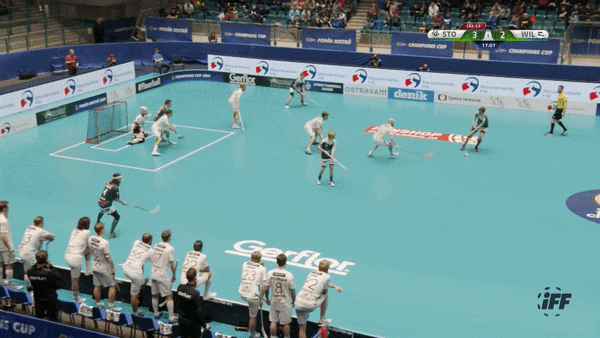
Storvreta defends the powerplay not in the 1-2-1 formation, but in 2-1-1 with Henrik Stenberg as the highest player. Jan Burki (#71) gives the pre-assist by reaching Michal Dudovic, although his pass is not without risk and Stenberg can only just not intercept him. However, by moving the ball there is room for Joonas Pylsy, although Storvreta is also unlucky that Pylsy simply finishes it off very nicely (video: IFF).
3. Omar Aldeeb vs. Linköping
A ‘simple’ form of powerplay is what Falun shows here. Omar Aldeeb plays the ball wide to Emil Johansson, gets it back and shoots: goal. Video from innebandy.tv.
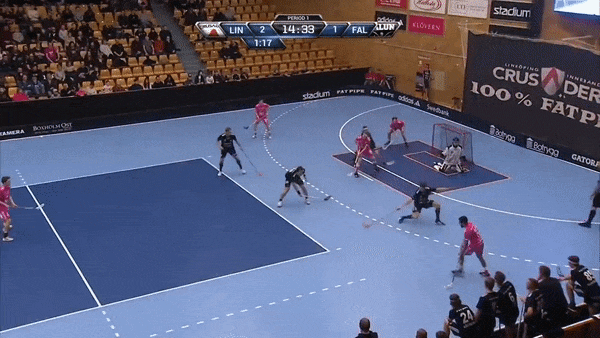
Summary
Using drawn and real examples I tried to give you an explanation of the basics of playing powerplay. Also, the pitfalls have been mentioned, for example when losing the ball.
In offense, it remains important to always have safe options to apply to. In addition, players should have a threat to the goal and know exactly what to do if the ball is lost
As mentioned earlier, I will deal with defending a powerplay situation in a later article. If you have any questions about this, please let me know! I may then be able to discuss it directly in the article. If you have any questions about the current article, you can of course also contact me via social media, Patreon or the website.
[/ppp_patron_only]


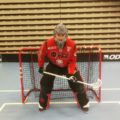


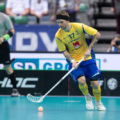
No Comments
Leave a comment Cancel